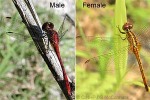Cook Islands Biodiversity Database
Species Page
Diplacodes bipunctata
Karakara‘avaiSmall Red-body Dragonfly
Multimedia & Additional Resources
| Type | Description | Download |
| Male (red) and female (yellow) | 49KB | |
| Male (red) | 63KB | |
| Female (yellow) | 74KB |
General Information
Cook Islands Distribution
| Southern Group: Present Makatea: Present | ||||||||
RR |
MG |
AT |
MK |
MT |
AK |
PL |
TK |
MN |
+++ |
P |
P |
++ |
|||||
| Northern Group: | |||||
TN |
MH |
RK |
PK |
NS |
SW |
+++ |
|||||
Scientific Taxonomy
Diplacodes bipunctata (Brauer, 1865)
SYNONYMS: Libellula bipunctata Brauer, 1865; Cordulia novae-zelandiae Brauer, 1865; Diplax bipunctata Brauer, 1865; Diplax pacificus Kirby, 1884
TAXONOMY: ANIMALIA; ARTHROPODA; ATELOCERATA; HEXAPODA; INSECTA; PTERYGOTA; Odonata; Anisoptera; LIBELLULIDAE
More Information
IDENTIFICATION: Small-sized dragonfly, wingspan to 55mm, body 35mm. BODY bright red or yellow-green; abdomen with 4 narrow brown bands; head brown; legs brown. WINGS clear except for brown-yellow spot on base of hindwing; wingtip rectangle dark red. RESTS with wings pointing down and forward. MALE abdomen red with black lateral markings on sements 4-7; FEMALE yellow-green with fine black dorsal line forming posterior spots on segments 4-7.
Vouchers & References
Vouchers:
Rarotonga: in Ris 1909; specimens 9/1937, C.E.Clarke, reported Wise (1980); specimens, Takuvaine Valley, 9/1969, Wise 1980; specimens, 1950-51, in Lieftinck 1953; specimen 10/1975 in Walker & Dietz 1979; specimens, lowland, 8/1997, L.Doig; specimen, Raemaru track, 200m elev. 5/2003, G.McC for BPBM. Mangaia: specimens, 9/1969, Wise 1980; specimen, male, near Kaumata Village, 6/1996, Coll.R.Fricke, ID A.Martens in Odonatologica 4(9)137-152. Atiu: specimens, 9/1969, Wise 1980. Mitiaro: fieldsighting+photos, NBSAP visit 2000, GM. Pukapuka: specimens+photo, PK028=M, PK029=F, 2/2004, common everywhwere, ID GMcC.
References:
Special Reference: W&D79,
Data Update History (information):
zTX, zB02, zM02, zupM04a, zD02
Web Resources
Citation Information
McCormack, Gerald (2007) Cook Islands Biodiversity Database, Version 2007.2. Cook Islands Natural Heritage Trust, Rarotonga. Online at http://cookislands.bishopmuseum.org. ![]()
Please refer to our use policy.

